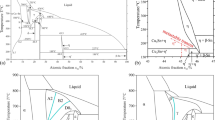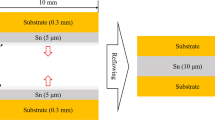Abstract
Bismuth (Bi)-based systems are of great interest as it is considered to potentially replace high lead (Pb)-content solders used in high temperature electronics. In particular, molten Bi strongly reacts with Ni to form higher melting point intermetallic compounds (IMCs) via transient liquid phase (TLP), which can offer a joining method alternative to the traditional solder approach. A fundamental understanding of nucleation and growth of intermetallic phases is crucial to create a reliable joint. Two intermetallic phases form between Bi and Ni (Bi3Ni, BiNi). In this study, growth kinetics for Bi3Ni and BiNi was investigated, both of which show a parabolic growth behavior. Bi3Ni exhibits rapid growth and apparent activation energy of 65.5 kJ/mol at lower temperatures (from 160 to 240 °C) and of 132.9 kJ/mol at higher temperatures (> 240 °C), where the transition is likely due to a viscous-flow nature near melting temperature of Bi. On the other hand, BiNi grows at a later stage with a slower rate with the apparent activation energy of 125.6 kJ/mol (from 260 to 340 °C). In addition, based on the formation sequence and growth direction of these IMCs, interdiffusion coefficients for each of these IMCs were determined. Micro-hardness tests show that Bi3Ni is softer and more brittle than BiNi.














Similar content being viewed by others
References
Y. Li, C.P. Wong, Recent advances of conductive adhesives as a lead-free alternative in electronic packaging: materials, processing, reliability and applications. Mater. Sci. Eng. R Reports 51(1–3), 1–35 (2006)
H. Ma, J.C. Suhling, A review of mechanical properties of lead-free solders for electronic packaging. J. Mater. Sci. 44(5), 1141–1158 (2009)
C. Buttay, D. Planson, B. Allard, D. Gergogne, P. Bevilacqua, C. Joubert, M. Lazar, C. Martin, H. Morel, D. Tournier, C. Raynaud, State of the art of high temperature power electronics. Mater. Sci. Eng. B 176(4), 283–288 (2011)
P.G. Neudeck, R.S. Okojie, L.-Y. Chen, High-temperature electronics—a role for wide bandgap semiconductors? Proc. IEEE 90(6), 1065–1076 (2002)
V. Chidambaram, J. Hattel, J. Hald, High-temperature lead-free solder alternatives. Microelectron. Eng. 88(6), 981–989 (2011)
Z. Zhang, G.-Q. Lu, Pressure-assisted low-temperature sintering of silver paste as an alternative die-attach solution to solder reflow. IEEE Trans. Electron. Packag. Manuf. 25(4), 279–283 (2002)
J.F. Li, P.A. Agyakwa, C.M. Johnson, Interfacial reaction in Cu/Sn/Cu system during the transient liquid phase soldering process. Acta Mater. 59(3), 1198–1211 (2011)
J. Cho, R. Sheikhi, S. Mallampati, L. Yin, D. Shaddock, Bismuth-based transient liquid phase (TLP) bonding as high-temperature lead-free solder alternatives. in 2017 IEEE 67th Electronic Components and Technology Conference (ECTC), 2017, pp. 1553–1559
J. Cho, S. Mallampati, R. Tobias, H. Schoeller, L. Yin, D. Shaddock, Exploring bismuth as a new Pb-free alternative for high temperature electronics. in 2016 IEEE 66th Electronic Components and Technology Conference (ECTC) (2016), pp. 432–438
J. Cho, S. Mallampati, H. Schoeller, L. Yin, D. Shaddock, Developments of Bi–Sb–Cu alloys as a high-temperature Pb-free solder. in 2015 IEEE 65th Electronic Components and Technology Conference (ECTC) (2015), pp. 1251–1256
H.-T. Lee, M.-H. Chen, H.-M. Jao, T.-L. Liao, Influence of interfacial intermetallic compound on fracture behavior of solder joints. Mater. Sci. Eng. A, 358(1–2), 134–141 (2003)
K. Prakash, T. Sritharan, Interface reaction between copper and molten tin–lead solders. Acta Mater., 49(13), 2481–2489 (2001)
O.V. Duchenko, V.I. Dybkov, Determination of NiBi3 reaction-diffusion constants in Ni–Bi couples. J. Mater. Sci. Lett. 14(24), 1725–1727 (1995)
V.I. Dybkov, O.V. Duchenko, Growth kinetics of compound layers at the nickel-bismuth interface. J. Alloy. Comp. 234(2), 295–300 (1996)
M.S. Lee, C. Chen, C.R. Kao, Formation and absence of intermetallic compounds during solid-state reactions in the Ni–Bi system. Chem. Mater. 11, 292–297 (1999)
M.S. Lee, C.M. Liu, C.R. Kao, Interfacial reactions between Ni substrate and the component Bi in solders. J. Electron. Mater. 28(1), 57–62 (1999)
J.H.L. Luhua Xu, K.H. Pang, Prakash, T.H. Low, Isothermal and thermal cycling aging on IMC growth rate in lead-free and lead-based solder interface. IEEE Trans. Components Packag. Technol. 28(3), 408–414 (2005)
C. Wagner, The evaluation of data obtained with diffusion couples of binary single-phase and multiphase systems. Acta Metall. 17(2), 99–107 (1969)
S. Bader, W. Gust, H. Hieber, Rapid formation of intermetallic compounds interdiffusion in the CuSn and NiSn systems. Acta Metall. Mater. 43(1), 329–337 (1995)
G. Vassilev, N. Milcheva, M.C. Record, R. Mancheva, Diffusion couple studies of the Ni–Bi–Sn system. J. Min. Metall. Sect. B 48(3), 347–357 (2012)
H. Schoeller, J. Cho, Superplasticity from viscous flow in high Pb ternary alloy. Mater. Sci. Eng. A 658, 210–220 (2016)
A. Paul, C. Ghosh, W.J. Boettinger, Diffusion parameters and growth mechanism of phases in the Cu–Sn system. Metall. Mater. Trans. A 42(4), 952–963 (2011)
S.R. Cain, J.R. Wilcox, R. Venkatraman, A diffusional model for transient liquid phase bonding. Acta Mater. 45(2), 701–707 (1997)
L. Pauling, Atomic radii and interatomic distances in metals. J. Am. Chem. Soc. 69(3), 542–553 (1947)
Acknowledgements
This project was financially supported by Integrated Electronics Engineering Center (IEEC) of Binghamton University (State University of New York). In addition, we used the equipment facilities at Analytical and Diagnostics Laboratory (ADL) of Small Scale Systems Integration and Packaging (S3IP) Center for some of materials characterization data presented here. We also thank Liang Yin, David Shaddock, Kaustubh Nagarkar and Arun Gowda from GE for their support on this project. Furthermore, the assistance provided by Sandeep Mallampati, a former member of our group, is greatly appreciated.
Author information
Authors and Affiliations
Corresponding author
Rights and permissions
About this article
Cite this article
Sheikhi, R., Cho, J. Growth kinetics of bismuth nickel intermetallics. J Mater Sci: Mater Electron 29, 19034–19042 (2018). https://doi.org/10.1007/s10854-018-0029-6
Received:
Accepted:
Published:
Issue Date:
DOI: https://doi.org/10.1007/s10854-018-0029-6




